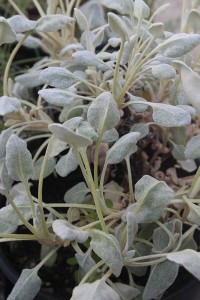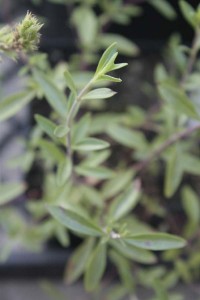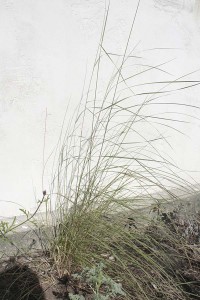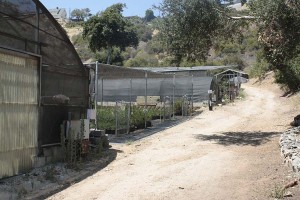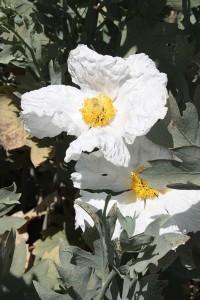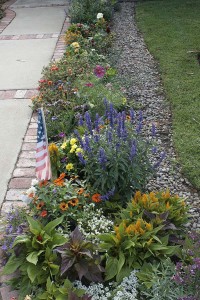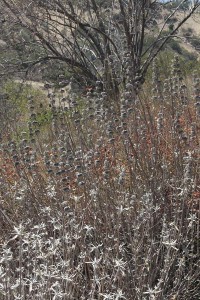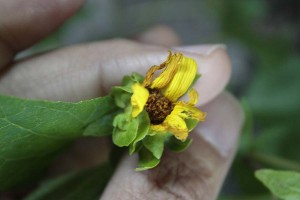In the spirit of the “haul video,” the art form in which a fashion-conscious usually young consumer describes his or her latest finds from the last shopping trip to the mall–a video in which the word “cute” has to appear at least fourteen times–let me show off my latest finds on my recent excursion to the Theodore Payne Foundation. (You didn’t think I’d go there and only pick up a couple plants for Aunt Barbara, did you?)
This first photo, a dark-flowered selection of desert willow, Chilopsis linearis, is a plant I did not buy. But if I manage to kill of one of my existing large shrub-sized plants in a spot that receives some summer water, this plant will be near the top of my list.
I also didn’t picky up any of the cool selection of pots.
But I did buy a few plants, including:
Verbena lilacina ‘Paseo Rancho,’ a light pink selection of the usually lavender Cedros Island verbena. You might call its color a little on the pale and insipid side, but it’s different from the other clones in my garden. Insipid but different, and maybe just a little cute. Reason enough to have it.
Cliff lettuce, or Dudleya caespitosa. Cute, huh? Ever the collector, I think it might be fun to explore some of the dozens of Dudleya species that grow in California.
Coast buckwheat, Eriogonum latifolium. I don’t really know this plant–which is sometimes reason enough to try to get to know it better. It’s been described as being similar to San Miguel Island buckwheat (E. grande). To me it looks like the leaves are a little more deluxe, thicker, fuzzier.
This plant, along with the preceding two selections, isn’t native to my immediate area. But being coastal or island plants, I’m hoping they’ll like what I have to offer them. The rest of my haul, however, consists of species that grow in my county, some of them not far from me.
San Diego ragweed, San Diego ambrosia–whatever you want to call Ambrosia pumila. The leaves are really delicately cut, like some artemisias, and I think this diminutive plant really does qualify as “cute.” This is a species that’s listed on the CNPS list of rare plants and proposed for the Federal Endangered Species list. It’s weird to travel 140 miles to get a mile that grows nearby, but that’s the responsible thing to do. Our local CNPS plant sales also have offered this plant. Yanking these up out of the ground where they grow nearby would be grossly tacky and totally illegal.
San Diego willowy monardella, Monardella linoides ssp. viminea, is another local plant that’s listed by both the state and federal agencies as endangered. It’ll have delicate whorls of lavender flowers when it blooms. But like most (or maybe all?) monardellas it has intensely fragrant leaves that I can enjoy right now.
And finally, one of my favorite of the softly delicate grasses, Aristida purpurea, purple three awn. It’s slightly more coarse than the popular Mexican feather grass that’s non-native and starting to look like it’s invasive. But it moves just as amazingly in the wind, and has a delicate purple tinge part of the year, something feather grass doesn’t offer.
August isn’t high season for planting, but with this cool summer-that-never-was I figured I could get away with it. And really, here, not that far from the coast, the main issue with many plants is water.
I hate to show newly installed plants before they have a chance to fill in, but here’s the finished bed where all of the plants except for the monardas went into. These Californians should be better choices for this exposed, dry spot than some of the exotics that I had in there before. Not shown in this photo is a very happy Cleveland sage and some ecstatic purple three awn plants that I grew from seed.
I haven’t counted all the “cutes” in my writeup. I know I’ve failed miserably, partly because I really dislike the word unless I’m discussing my extremely cute cat. I will try to do better if I decide to commit my shopping trips to video.






